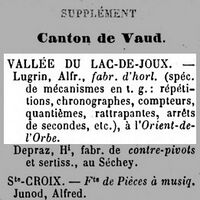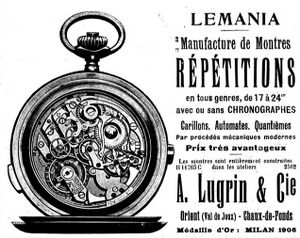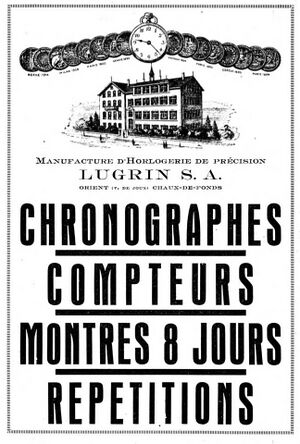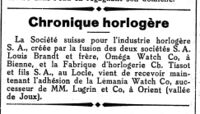Lemania: Difference between revisions
No edit summary |
No edit summary |
||
| Line 5: | Line 5: | ||
__TOC__ | __TOC__ | ||
== Foundation by Alfred Lugrin == | == Foundation by Alfred Lugrin == | ||
[[File:Davoine 1886 0214 Alfred Lugrin.jpg|right|thumb|200px|This 1886 announcement was the first mention of Alfred Lugrin's firm]] | |||
:See Also: [[Alfred Lugrin]] | :See Also: [[Alfred Lugrin]] | ||
[[Alfred Lugrin]] (1858-1920) established a workshop to manufacture "mécanismes en tous genres", specifically "[[repeater|répétitions]], [[chronograph|chronographs]], [[stopwatch|compteurs]], [[calendar|quantièmes]], [[rattrapante|rattrapantes]], [[dead-beat seconds|arréts de secondes]], etc." in [[l'Orient|l'Orient-de-l'Orbe]] in February [[1885]]. Lugrin was son of Jules Lugrin, Bourgeois of Lieu and had previously worked at [[Jaeger-LeCoultre]] in nearby [[Le Sentier]]. He found quick success based on his inventiveness (as reflected by dozens of patents), access to talented watchmakers in the [[Vallée de Joux]], and location between [[Geneva]] and the [[Jura triangle]]. Lugrin advertised heavily through the 1890s, gaining many clients throughout Switzerland and becoming a viable competitor for the nearby [[Le Brassus]] workshop of [[Louis-Elisée Piguet]]. Lugrin and Piguet remain leaders in the field of complicated movements to the present day as [[Manufacture Breguet]] and [[Manufacture Blancpain]], respectively. | [[Alfred Lugrin]] (1858-1920) established a workshop to manufacture "mécanismes en tous genres", specifically "[[repeater|répétitions]], [[chronograph|chronographs]], [[stopwatch|compteurs]], [[calendar|quantièmes]], [[rattrapante|rattrapantes]], [[dead-beat seconds|arréts de secondes]], etc." in [[l'Orient|l'Orient-de-l'Orbe]] in February [[1885]]. Lugrin was son of Jules Lugrin, Bourgeois of Lieu and had previously worked at [[Jaeger-LeCoultre]] in nearby [[Le Sentier]]. He found quick success based on his inventiveness (as reflected by dozens of patents), access to talented watchmakers in the [[Vallée de Joux]], and location between [[Geneva]] and the [[Jura triangle]]. Lugrin advertised heavily through the 1890s, gaining many clients throughout Switzerland and becoming a viable competitor for the nearby [[Le Brassus]] workshop of [[Louis-Elisée Piguet]]. Lugrin and Piguet remain leaders in the field of complicated movements to the present day as [[Manufacture Breguet]] and [[Manufacture Blancpain]], respectively. | ||
Revision as of 03:44, 18 January 2024
|
Lemania
|
Lemania (originally called Lugrin) was a historic Swiss ebauche movement and complicated watch manufacturer. It is now called Manufacture Breguet and is part of Breguet in the Swatch Group.
Foundation by Alfred Lugrin

- See Also: Alfred Lugrin
Alfred Lugrin (1858-1920) established a workshop to manufacture "mécanismes en tous genres", specifically "répétitions, chronographs, compteurs, quantièmes, rattrapantes, arréts de secondes, etc." in l'Orient-de-l'Orbe in February 1885. Lugrin was son of Jules Lugrin, Bourgeois of Lieu and had previously worked at Jaeger-LeCoultre in nearby Le Sentier. He found quick success based on his inventiveness (as reflected by dozens of patents), access to talented watchmakers in the Vallée de Joux, and location between Geneva and the Jura triangle. Lugrin advertised heavily through the 1890s, gaining many clients throughout Switzerland and becoming a viable competitor for the nearby Le Brassus workshop of Louis-Elisée Piguet. Lugrin and Piguet remain leaders in the field of complicated movements to the present day as Manufacture Breguet and Manufacture Blancpain, respectively.
Lugrin was among the first to submit a patent application, completing the drawings for his "Nouveau système d'accrochement et de décrochement pour montres à répétition" on December 20, 1888, just over a month after the Swiss patent office opened. This application was granted as CH225 on February 11, 1889. His next patent was for "Perfectionnements apportés à la construction des chronographes-compteurs" and was granted as CH359 on March 18, 1889. This was licensed on January 7, 1890 to Jules-Frédéric Jeanneret who soon began production of chronographs in Saint-Imier based on Lugrin's ideas. A third patent that year, "Mécanisme de montre à répétition à minutes, système simplifié et perfectionné", was granted as CH782 on April 5.
By 1893, Lugrin had built a true factory with hydraulic power, enabling him to produce ebauches and invest in modern lathes and other machines. Lugrin's movements were marked with his initials "A.L." along with a star and anchor positioned in a cross or heart.
In 1890 Lugrin began construction of a larger factory with hydraulic power, enabling him to produce ebauches and invest in modern lathes and other machines. He added production of chronograph and repeater modules which were available to other companies, fueling the explosion of complicated watches hitting the market by the turn of the century. Lugrin's movements were marked with his initials "A.L." along with a star and anchor positioned in a cross (since 1890) or heart (1893).
The factory was producing high-quality finished watches for customers by 1900. It had been modernized with electric lighting powered by a turbine fed by a spring on the mountain. Lugrin's repetition and chronograph complications earned him a gold medal in Milan in 1906 and Berne in 1914. Many Lugrin movements also included advanced calendar functions, including windowed day and month and moon phase. His chronographs often included rattrapante functions.
The company was known as A. Lugrin & Cie. following a May 1905 reorganization that saw Auguste Jacques invest 10,000 francs in its expansion. This was apparently paid back in March 1908 as Jacques signing authority was revoked. Henri Golay joined management in October of that year with a 1,000 franc investment. The firm's office is noted as being Rue du Commerce 17a in 1913.

The firm now produced electric clocks and electricity meters as well as complicated watches and opened a new office in La Chaux-de-Fonds in the Montbrillant Watch Manufactory. The new company registered the "Lemania" name in March 1906 alongside the brands Oberon, Rejane, Boudha, Orpheon, Phenix, Superius, Regata, Neron, Sultana, Velocitas, though it is unclear if the firm sold watches using any of these brands. More brands were added in 1909, including Edison Watch, La Vaudoise, and Osram.
The firm also registered an early tachymeter scale dial in May 1907. By 1913 Lugrin offered a 13 ligne wrist chronograph based on a pocket watch calibre with the crown on the left.
SA de la Fabrique d'Horlogerie Lugrin and Lemania
On January 26, 1918, the Société Anonyme de la Fabrique d'Horlogerie Lugrin was established. Initially capitalized at 150,000 francs, this share company absorbed the assets of A. Lugrin & Cie, which was deleted from the register in 1919. Lugrin remained in charge but he was joined in management by his son, also called Alfred Lugrin, and by his son-in-law, Marius Meylan-Lugrin.
Alfred Lugrin died on December 27, 1920, leaving the firm to his son in law, Marius Meylan, and son, Alfred.

Lugrin had registered the Lemania brand on March 14, 1906, and used it specifically for repeater watches in the pre-war era. Chronographs without repetition were specifically not branded using the Lemania name. Lemania refers to the French name for Lake Geneva, Lac Léman, though the company rarely used the acute mark above the e in official advertisements or publications. But the Lemania brand name was also used by Louis Mermin of Geneva in later years. Mermin registered his firm in 1915 and originally used the Astoria brand, renaming the company Fabrique Lemania in 1918. He specialized in wristwatches and pendant watches in the latest styles for export. Lugrin published a notice in 1923 that it intended to enforce its ownership of the name. Before action could be taken, Mermin's company failed and was deleted from the commercial register in August 1924. One month before this, on July 30, Meylan re-registered his family firm as Fabrique d'Horlogerie Lemania Lugrin S.A. (Lemania Watch Co. Lugrin Limited).
Alfred was removed from management in April 1927, replaced by Justin Redard.
The La Chaux-de-Fonds branch was closed in 1932, with Lemania Lugrin focused in the Vallée de Joux from that point on. The Lugrin name gradually disappeared from use and was gone from advertisements starting in the 1940s.
Merger with Tissot and Omega

In 1930 Omega, and Tissot joined to form the SSIH group. Lemania was added to the group in 1932, and Meylan welcomed Paul Tissot and Gustave Brandt as administrators of Lemania Lugrin on December 12, 1934.
In close collaboration with Omega great chronograph calibres were created.
The Lemania Calibre 1873 (Omega Calibre 861) became particularly famous with the Omega Speedmaster, which in 1962 was selected by NASA for manned space flights and on 21 July 1969 accompanied Neil Armstrong's first steps on the moon. Lemania then worked with Omega to develop a high-quality cam switching automatic chronograph, launching their Cal. 1340 in 1972. This was followed by the 1974 introduction of Cal. 5100.
With the advent of electronic watches in the 1970s the sales of mechanical watches by the SSIH group broke in massively. In 1980 the creditor banks gave Nicolas Hayek the mandate to restructure the group. As part of a management buy-out Lemania was separated by the SSIH Group in 1981 and changed its name to Nouvelle Lemania. In 1992, Nouvelle Lemania was brought under the Groupe Horloger Breguet banner. At this time, the company re-introduced their cam-switching automatic chronograph as Cal. 1350. They constructed a new manufacture in L’Abbaye in 1996.
Breguet was acquired by the Swatch Group in 1999. Over the next decade, the Lemania name was retired, with the company now called Manufacture Breguet. The company primarily produces calibres for Breguet, but many of its products are also used by other Swatch Group brands. Although Lemania's ownership by SSIH brought it very close to ASUAG, Ebauches SA, and SMH/Swatch Group, it was never part of this conglomerate or of ETA, their movement manufacturer.
Movements
Lemania has produced many famous movements, including the following:
- Manual Chronograph
- 1270/1275/1276/1277 - cam switched, 30 minute counter and 60 second subdials
- 1280/1281 - cam switched, 30 minute and 12 hour counters and 60 second subdials
- 1872 (1961) - cam switched, 30 minute and 60 second subdials
- 1873 - cam switched, 30 minute and 12 hour counters and 60 second subdials, optional 24 hour display (aka Frank Mueller 1870, Omega 861/863, Universal Genève 84)
- 1874
- 1877 - Breitling Calibre 12
- 1883 (1983) - cam switched, 30 minute and 12 hour counters and 60 second subdials, date and moon phase
- 1888 - (aka Ulysse Nardin UN 53)
- 5200/5250 - pillar wheel
- 2310/2320/2612 (1942) - pillar wheel, Patek Phillipe 2872 (2310) and CH 27-70 (2310), Omega 321 (2310), Vacheron Constantin 1141 (2320)
- 1270/1275/1276/1277 - cam switched, 30 minute counter and 60 second subdials
- Automatic Chronograph
- 1340 (1972) - cam switched, central chronograph seconds and 60 minute totaliser hands, 12 hour counter at 6:00, small seconds at 9:00, quickset date at 3:00
- 1341 - adds 24-hour hand at 9:00 (Omega 1040)
- 1343
- 5100/5012 (1974) - cam switched, central chronograph seconds and 60 minute counter hands, 12 hour counter at 6:00 and small seconds and 24 hour hand at 9:00, quickset day and date, hacking
- 1350 (1994) - cam switched
- LWO 283 - ETA 2892 with Dubois-Depraz chronograph module - BM 13283
- 1340 (1972) - cam switched, central chronograph seconds and 60 minute totaliser hands, 12 hour counter at 6:00, small seconds at 9:00, quickset date at 3:00
- Automatic time-only
Patents
- CH225, February 11, 1889 - Nouveau système d'accrochement et de décrochement pour montres à répétition
- CH359, March 18, 1889 - Perfectionnements apportés à la construction des chronographes-compteurs - licensed on January 7, 1890 to Jules-Frédéric Jeanneret
- CH782, April 5, 1889 - Mécanisme de montre à répétition à minutes, système simplifié et perfectionné
- CH3883, August 28, 1891 - Perfectionnement apporté à la construction des chronographes-compteurs
- CH6420, March 16, 1893 - Montre „Boston« avec chronographe noyé dans la platine
- CH12175, May 22, 1896 - Mécanisme de chronographe-compteur
- CH12662, July 31, 1896 - Mécanisme d'accrochement et de décrochement pour montres à répétition
- CH13803, February 3, 1897 - Mécanisme simplifié de répétition
- CH15522, October 16, 1897 - Mécanisme modérateur du petit rouage des montres à répétition
- CH17189, December 18, 1898 - Chronographe compteur de minutes
- CH21123, March 26, 1900 - Noureau système de mise en marche de la sonnerie d'une montre à répetition, par un poussoir
- CH23649, April 26, 1901 - Régulateur-modérateur de vitesse perfectionné pour mécanismes d'horlogerie
- CH23754, April 27, 1901 - Mécanisme de répétition
- CH23763, April 2, 1901 - Perfectionnement aux mouvements d'horlogerie à commande électrique
- CH23765, May 27. 1902 - Lame de ressort-timbre pour montres à sonnerie - registered by P. Mercier-Mayer and Charles Glauser-Perrin and handed over to A. Lugrin on February 9, 1905
- CH26285, July 26, 1902 - Mécanisme de répétition à trois marteaux
- CH33812, June 26, 1905 - Mouvement de compteur de sport
- CH34495, August 1, 1905 - Compteur horaire d'électricité
- DE173843, July 14, 1906 - Elektrischer Schalter mit Zeitmesser
- CH44553, October 27, 1908 - Compteur de temps pour sports
- CH56063, March 21, 1911 - Compteur de temps pour sports